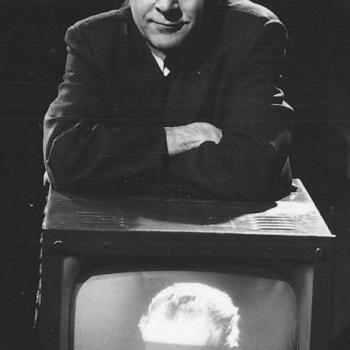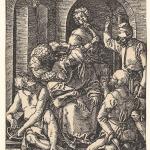I have just finished a book that I am going to count among my favorites of all time. It is that good. You have GOT to read it. It’s entitled Evening in the Palace of Reason: Bach Meets Frederick the Great in the Age of Enlightenment by James A. Gaines.
by James A. Gaines.
In 1747, Frederick the Great–the king of Prussia, patron of Enlightenment rationalism, and military strongman–invited Johann Sebastian Bach, now an old man three years from his death, for an audience. Frederick fancied himself a musician and scorned the old-fashioned polyphony that Bach was known for in favor of music with a single pleasant melody. Frederick, who enjoyed humiliatating his guests, had composed a long melody line full of chromatic scales that was impossible to turn into a multi-voiced canon (that is, a “round”: think “Row, Row, Row Your Boat” with different groups starting at different times) and told Bach to turn it into a fugue (an even more complicated “round”). Whereupon Bach, on the spot, sat down at one of the new piano fortes and turned it into a three-part fugue. The flummoxed King said, in effect, OK, turn it into a 6-part fugue. A few days later, Bach sent him a 6-part fugue and more than a fugue, “A Musical Offering” that rebuked Frederick and all of his Enlightenment notions with the Christian faith.
This book tells about that confrontation and the events in each man’s life that led up to it. Gaines, in effect, gives us a dual biography, with alternating chapters on each subject. We learn about Frederick’s miserable childhood with an abusive father, the previous king (who, at one point, had his son’s best friend beheaded and made him watch, thinking that he would be next). Then we learn about Bach’s happy childhood in a Christian home. We learn about Frederick’s unhappy and childless marriage. Then we learn about Bach’s family, in which he was a loving husband and father of 20 children. We learn about Frederick’s decadent love of the arts and his infatuation with the Enlightenment, and his mutual admiration society with Voltaire. Then we learn about Bach’s deep Christian faith and his orthodox Lutheran theology. We learn about Frederick’s ascension to the throne, his turning Prussia into a military powerhouse, and his unprovoked wars against his neighbors for nothing more than his ego. We learn about Bach’s career at courts and churches, his stubborn integrity that caused him to battle with virtually all of his employers, and, despite occasional musical respect, how he died in obscurity with his music all but forgotten. We also learn about the aftermath, how Frederick’s legacy would blossom but burn out under Hitler. And how Bach was rediscovered by Mendelssohn in the 19th century, whereupon he has become recognized as arguably the greatest musical composer and one of the greatest artists in any form ever.
The author, James Gaines, is a journalist–a former editor of TIME–and so, though he knows his music as an amateur classical musician, he writes not with scholarly heaviness but with a lively and enjoyable narrative flair. And his secular background makes the book all the more remarkable for what it says about the relationship between Christianity–indeed, Lutheranism–and art. Gaines suggests that Bach was a greater man and a greater creator than Frederick precisely because of his faith. Bach was transcendent because he built his life on something transcendent.
Gaines shows how Bach’s view of music goes right back to Luther. For them and other Christians of their time, music was quite literally a sign and measure of God’s created order in the universe. Bach and Luther favored polyphony–many voices going on at the same time, whether in the multiple but unified melodies of canons and fugues, or in the phenomenon of harmony–because it imaged forth the unity-in-diversity that is everywhere in creation; indeed, in existence itself; not only that, but in the Godhead Himself.
Gaines also draws on the Bach scholarship that demonstrates how music in this tradition encoded specific meanings. In Bach’s final “Musical Offering” to Frederick, he includes 10 canons, which are emblematic of the Ten Commandments (“canons,” laws, get it?). He includes a caption in one section that refers to how the notes ascend like the King’s glory, except that the notes go nowhere and turn into the most melancholy of melodies. He thus says through his music that Frederick may think himself “Great,” but his glory goes nowhere, that he will end only in death, that he doesn’t stand up very well to those Ten Commandments. Bach works in chorale motifs and church music–which Frederick hated–but which give this king his only hope. Yes, Bach was using his music to witness to this august secularist King in his palace of reason.
You will learn a lot about music and a lot about history in this book. It is also one of the best books about the relationship between Christianity and the arts that I have ever come across. It also illuminates the relationship between Lutheranism and the arts. Gaines keeps bringing Luther into his story, to the point of saying that Bach and Luther had the same personality (intemperate, stubborn, no-comprising, but also warm and sensitive and devout). We learn surprising things, such as the way Enlightenment skepticism had a rather harder time in Lutheran countries than in those of other theologies, since Lutheranism had already developed a vigorous intellectual tradition that had thoroughly worked out the relationship between faith and reason. We also learn about the magnificent use of music in Lutheran worship that was unique to any other religious tradition.
And we confessional Lutherans can also appreciate what Gaines does not go into, that Frederick the Great, with his religious “toleration” was literally the grandfather of the Prussian Union, that ecumenical amalgamation and theological watering down of the state church in the name of enlightenment principles, that two kings later would send orthodox Lutherans fleeing to America and other New Worlds. Gaines also makes outstanding use of Bach’s notations in his Calov Study Bible, which happens to be owned by Concordia Seminary in St. Louis and which I have held in my hot little hands.
So drop whatever you are doing and buy this book. You will be glad you did. Here, I will make it easy for you:
by James A. Gaines.
















